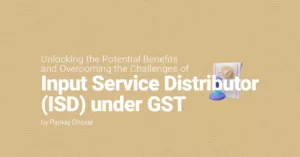- Faceless tax assessments were launched on 7th October 2019 with over 50,000 preliminary cases
- The procedure is meant to induce transparency in the tax assessments regime and promote more citizens to pay taxes
- However, tax officials have expressed concerns over the process with a lack of infrastructure and facilities to carry out the same
- CBDT’s high-ranked officials and Chairman have come out in support of the system, and have vouched for its robustness
As part of the new tax amendments proposed in the Union Budget 2019 in July and those which followed later in September, the Government further advocated for the use of faceless e-assessments when it comes to tax returns. The whole idea stemmed from the need of minimizing the contact between the taxpayer and the authorities and making the entire process of income tax assessments digitized, unified and streamlined across a chronology of processes.
The regime was preceded by the formation of the NeAC (National E-Assessment Centre) in the capital city of New Delhi, with various distinguished individuals being a part of the proposed panel. It was inaugurated by the FM and the process of e-assessments has been initiated wherein 58,322 cases has been selected for scrutiny and e-notices has been served before 30th September 2019 for the Assessment year 2018-19
The process was brought in by the Government of India and the CBDT (Central Board Of Direct Taxes) with randomly selected cases for the initial testing, with Revenue Secretary Ajay Bhushan Pandey inaugurating the e-assessments ecosystem in New Delhi and calling the process a landmark in the history of taxation in India. These selected cases were referred automatically to the 8 e-assessments centers across the country in different cities, and e-assessment notices have been communicated digitally for the same by the tax department.
While the aim to decrease face-to-face interaction between taxpayers and tax officials might sound tremendous on paper, there are a few areas where e-assessments might require certain checks and balances in order to ensure the process is fair and just. Chairman of the CBDT, Mr. Pramod Chandra Mody has assured of the robustness of the system, by talking about the 3 different units such as the Assessment Unit, the Technical Unit, the Verification Unit and finally the Review Unit in order to scrutinize a given tax return and eliminate a high-pitched assessment.
While on paper it seems robust and accounting for the fact that all the processes have been laid out, no significant results have yet been reported, even though the process has been initiated since 8th October 2019.
Income tax officials have themselves displayed apprehension towards the provision of faceless assessments, highlighting how this will further burden them further as adequate infrastructure and manpower isn’t currently available to implement this on a large scale.
As per Reuters, various tax officers have predicted a reduction in tax collection and increased pressure on the tax officers to meet the tax collection targets set for 2019-20.
Added to this, there is little to no clarity with respect to how the scrutiny process will be carried out by the officials put in place for the different units, and what type of software(s) and artificial mechanism will be deployed for the same (other than the ones mentioned by the Mr. Pramod Chandra Mody for allotment of cases) and what type of technology will be implemented. The idea of automation and random allocation has the propensity to boil over, wherein the primary problem of the removal of the “human element” becomes particularly note-worthy too.
The latter problem can be elaborated as such: The first being the tax scrutiny process in its preliminary stage. When it comes to human interference and representation, there are issues and discrepancies which are often not explained “on paper” but their impact is reflected on the sheets. With a human representative, it leaves a window of opportunity where the said assessee can choose to either represent himself or get represented by someone else to ensure that any discrepancy is ably sorted out.
With automated systems in place and no interaction between tax officials in different units and the taxpayer, the human element takes a backseat and any sort of discrepancy has the propensity to be treated as an offence, where no negotiation can be brought into the scenario.
Mr. Pramod Chandra Mody, however, has highlighted about a review mechanism where the assessee can explain his case via video conferencing, which we believe can add to the apprehension of this mechanism due to concerns of lack of digital and IT infrastructure to execute the same.
With the economy and its underlying mechanisms shifting to a digital age, faceless tax assessments seem to be right up the alley which leads to a more optimized taxation process.
But with increasing apprehension and conflicting views of different officials, we shall continue to monitor its results and further analyze it in our upcoming articles.
Do you have something to add to this? Let us know in the comments below!





